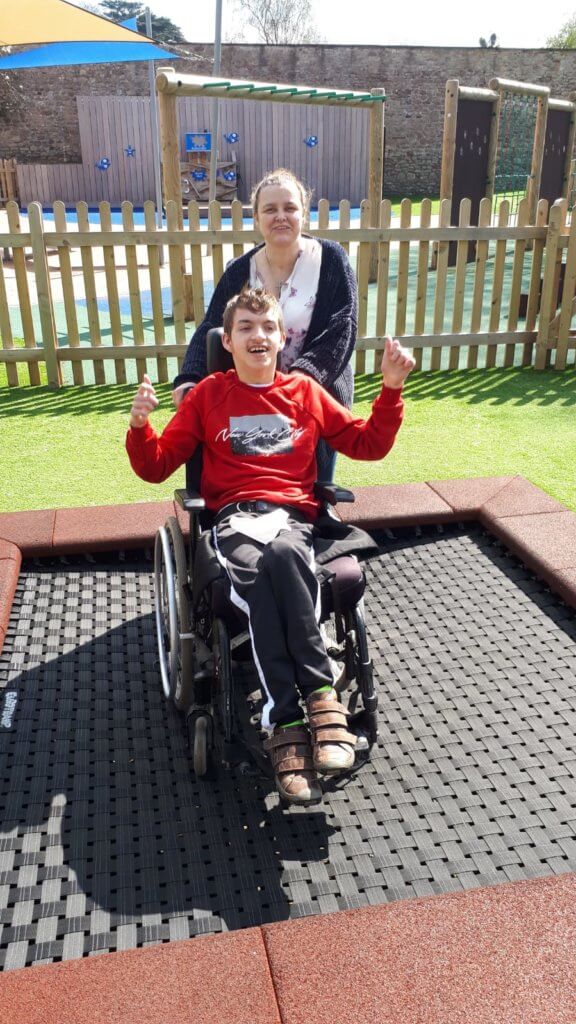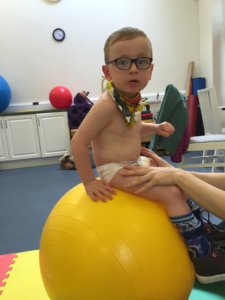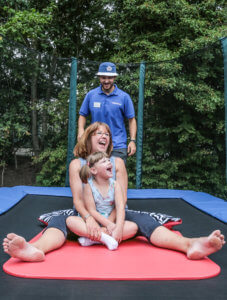21 Great Games and Sports for Wheelchair Users
Being active is great for our health and wellbeing. It maintains cardiovascular health (preventing conditions like stroke and heart disease), boosts mental health and self-esteem, and assists our bodies in managing blood sugar and insulin levels, which can help with weight control.
Exercise also has developmental benefits for children and young people. As well as supporting physical development (strength, stability, mobility), movement can boost cognitive skills like planning, problem solving and bilateral integration – using the two sides of the body and brain together.
While physical activity is beneficial for everybody, it can be harder for wheelchair users to access exercise opportunities. With this in mind, we have created a resource of fun games and adapted sports our children can enjoy at home – whatever their physical abilities.
It’s important to remember any movement counts as activity: it doesn’t need to look like traditional exercise or sport. Anything that gets our child moving a little bit more than normal will help them get fitter and stronger.

Improves strength which leads to better gross motor skills and more independent living.
Helps maintain or increase muscle length through active stretch, keeping ranges of motion in the joints and enabling better gross motor skills – and thus improved function and independence.
Improves sleep which is very often a problem for those with physical difficulties.
Reduces constipation: as the body moves the muscles in the stomach contract, moving stomach contents. This can help with painful trapped wind and constipation.
Protects joints by increasing muscle strength. This takes the pressure off joints and can ease or prevent joint pain.
The pull of muscles and bearing weight through the bones both increase bone density – reducing the risk of fractures.
Exercise can reduce fatigue and improve exercise tolerance, improving function and independence in everyday tasks.
Here we have put together a list of our favourite exercises and activities for wheelchair users
-
Roll a ball or object between you on their tray or at a table.
-
Start with a big ball and get smaller as your child improves.
-
Try to stop the ball when it comes to you before rolling back.
-
Try rolling with more accuracy-e.g. into a container.
-
Try stopping the ball with two hands
-
Try stopping the ball with one hand.
Staying nice and close to each other, roll a balloon to your child and ask them to hit it back. This is great for cause and effect as little effort goes a long way and the balloon moves slowly so gives more time to aim the hit back.
As they improve, stand further apart and launch the balloon into the air rather than along the table/ tray.
-
Use a beanbag or soft toy to practice throwing into a container. Start with a big container or target very close to your child.
-
You could set up a ramp (piece of cardboard, tray or cushion) off their tray or lap to help them.
-
As your child gets more accurate, move the container further away.
-
To add challenge, try adding a sorting element. Throw toys/beanbags/rolled up socks into different containers. For example, green items could go into teh green bucket, red items in the red box. Or sort by type – farm animals go in one container, dinosaurs in another.
Set up a 10 pin bowling set with empty plastic bottles, toilet rolls or a pyramid of empty tins.
Start very close to the target.
Give your child a large soft ball or a soft toy to throw.
Encourage them to get more accurate by seeing how many throws it takes to knock them all over.
As your child gets more accurate, move the target further away.
You could also set up a points system by drawing a target on some cardboard and fixing it to the door or on the floor.
Use bits of paper or post it notes on the wall as more difficult targets-the higher and smaller the target, the higher the points. You could also put letters on the targets so your child can spell out a word.
This is a great game for two handed play and for improving hand-eye coordination
-
Give your child a bucket. this could rest on the floor or tray
-
Throw a beanbag or other soft toy into the air and they need to move the bucket to catch it.
-
As they get better, make the bucket or container smaller so they have to increase their accuracy.
-
You could also make the ball small or harder for an extra challenge.
Start with a big soft ball and standing/ sitting very close together. Roll the ball into your child’s hands so they get used to holding it and balancing the ball between 2 hands.
Ask your child to throw it back to you or their sibling and keep practising until they are accurate to you at a very small distance.
Start moving back a little so there is a gap between you.
Start making the ball a bit smaller-soft balls and beanbags are easier to catch than fully inflated balls. If you don’t have balls at home use rolled up socks, small cushions or soft toys.
Move onto large inflated balls such as footballs and then move on to smaller or harder balls.
Progress from 2 handed catches onto 1 handed catches.
Try also catching on their own-throwing into the air or against a wall.
Try moving further apart from each other one step at a time to increase the challenge.
If you are feeling brave try this outside with water balloons.
Dancing is a brilliant form of exercise. There are numerous YouTube channels with music to dance along to for younger kids. Older children will probably prefer pop music, or they may have their own favoured genre! Turn up the music and let your child dance however they want to.
Over lockdown, Bristol Bears ran a wonderful weekly “DanceTime” dance session for children with complex needs. All the dances are simple and seated. You can find the videos on their YouTube channel.
Just Dance / Just Dance Kids are great games where we can enjoy learning dance routines to well-known songs. You don’t need a gaming system to enjoy the Just Dance experience – there are plenty of videos to dance along to on YouTube, a number of which are seated. We’ve found a Just Dance seated playlist here, you find more songs by searching ‘Just Dance’ and ‘Seated’, ‘Sitting’. ‘Car’ or ‘Chair’.
Chelsie Hill has lots of wheelchair dance tutorials on her YouTube channel. Songs are contemporary and carefully choreographed, and of varying difficulty levels. These would be particularly good choices for teens and tweens.
- Have a look at our music page for musical ideas!
This is a great game to work visual skills. To begin with just hide an object under a piece of material on the tray with a big part of the object visible. Preferably an object of interest (a phone?!)
Encourage your child to pull the material away to reveal the whole object.
You can start to make this more complicated by hiding something behind a door with half of it poking out and see if they will notice/ point it out or try to reveal the item.
Lastly you could hide yourself, a sibling or object somewhere in the room and see if they can search it out with their eyes, point to it or, if they can move their wheelchair, can they go towards it?
If you don’t have a parachute at home then a sheet will do the same job.
Hold onto the edges between at least 3 of you.
Put objects onto the middle of the ‘parachute’ and make the objects move around the sheet by lifting or lowering your arms. You may need to help your child to hold on but they will get a lovely new perspective bringing the parachute up and down above and below their eye level. This is also a lovely way to get an arm stretch up in the air.
Set up the room so that there is a beanbag or soft toy on furniture at a height that is in easy reach of your child. Space the furniture out and put a laundry basket at the end.
If your child can wheel themselves or if they use an electric wheelchair then encourage them to do this activity themselves. If not, you can push them.
They need to go to the first beanbag and pick it up and put on their tray. They then go to the laundry basket and try and throw it in. Next go to the 2nd beanbag and take it to the laundry basket.
Continue until they have put all the beanbags into the basket. This is a lovely game to play with siblings as they can do a relay race playing the same game.
An egg and spoon race is a great way to challenge hand/ eye coordination and hand control.
Use a large spoon and a small ball. You can adapt this depending on your child’s needs. They may need a large spoon and a beanbag. Or a bucket and beanbag.
The child should try to get from A to B without the ball falling off their spoon/ beanbag out of their bucket.
Use whatever wheelchair mobility they have. For a child with more severe learning difficulties it may be that they just keep their hand on a ball on their tray and try not to let go!
Use a beanbag or soft toy for this. Help them put the item on their head and see if they can keep it on while they/ you wheel them from one end of the room to the other.
You may want to use a mirror when you put it on their head so they know what is going on.
You could also try putting a ball in their hand to see if they can hold on as you move them around gently or more roughly – depending on what they prefer.
Set up a balance board on a table or on the floor with a board and a bottle or rolling pin.
See this ‘Our Home’ video on how to set this up.
Any exercises on a gym ball feels like a game so is a great way to get some exercise without your child feeling they are working.
If your child has some sitting balance on the floor or on the bench/roll, you could try working some sitting balance on a moving object. This could be on a wobble cushion, on a gym ball or, if they fit on your lap, you could move your lap as a moving surface.

If using a gym/physio ball, make sure you have complete control of the ball and your child to try this – it may take 2 adults. If you are using the ball, you can wedge it into the corner of the room or between furniture to make it more stable until you are more confident in your handling.
Hold your child at their hips so you have control of their bottom and the ball. Very slowly move the ball back and forward or side to side.
As they get more confident you can move in bigger movements in all directions but keep going very slowly to challenge them. Hold the position at the extreme of where they can go to make it a little harder but have a second person ready to catch them if they fall.
Take photos of objects on your phone or tablet or print out the photos. Have a look at this ‘Our Home’ video on how to set one up.
Start by having a couple of objects on their tray and showing a photo of 1 of them and see if they can match it to the item.
If they are able to match objects, put the object further away (within their visual range).
Show the child 1 photo at a time and they need to find it in the room/ home.
If your child can’t wheel themselves or move on the floor, see if they can guide you to find the object with pointing and other forms of communication.
Make sure the objects are very desirable to keep your child engaged (e.g. food or a phone/tablet).
One person does an action and the other person has to copy them. This is a great way to convince your child to do any action you want from them!
Alternatively ask them to lead the game and see where their imagination takes you.
If your child would struggle with this concept, try copying everything they do. If they move their arm, you move your arm the same way. They may start moving just to make you move. There is a similar technique called intensive interaction for communication and you could try both together to see if your child will move and make sounds. To find out more about intensive interaction see this series dedicated to it.
Trampolining is a fantastic, fully inclusive activity. Whether your child is on their feet or in a wheelchair, they may well get benefits from having a bit of trampoline fun.
Be aware that there are some reasons NOT to use a trampoline – such as if your child has had spinal rodding, There are several other times to be cautious so make sure you check with your physiotherapist before going on the trampoline for the first time with your child.

If your child is not mobile, try them in different positions on the trampoline. For example if your child has not got sitting balance, they can lie supported by cushions while you very gently bounce them or walk around them on the trampoline. This will make them use different muscles to balance themselves.
You could do this with them in sitting if they have some sitting balance
Or try them on their hands and knees or sitting on a wedge.
You may need 2 people to help your child on the trampoline but this is definitely an activity that the whole family can enjoy!
Table cricket is played by children with all abilities and challenges. It is a great game to play with all the family and can be played using a regular table. This video Keeping fit and healthy at home: Table top tennisgives a quick demonstration of how to set up and play table cricket in the home.
Visit this video by the Lord’s Taverners | Rules of Table Cricket for more detailed explanations of how to play this great inclusive game.
You will need a big enough ball so that the footplates of the wheelchair can move the ball. If your child can wheel themselves, encourage them to move the ball towards a goal (between 2 chairs).
If your child can’t wheel themselves this could be a nice game to play with the family, passing to each other in a circle.
It may be that your child rolls the ball off the tray to their siblings/ parents so that they can participate as much as possible.
This is a fantastic game and involves playing in teams and getting your team’s ball nearest to a target ball.
It can be played with as few as 2 people and your child can play from their wheelchair. If you don’t have balls, use rolled up socks.
See our video for details of how to play.
This series by Bristol Bears is wonderful to move along to. Join in with as much as you can and help your child to move where possible. They have a different theme each day – Wednesday is exercise but the other days may be better for your child so check out the playlist on YouTube.
These videos are fully inclusive; using Makaton and simple instructions. If your child can’t manage on their own then help them to move. With repetition they may start to anticipate the next movement and do more for themselves.






